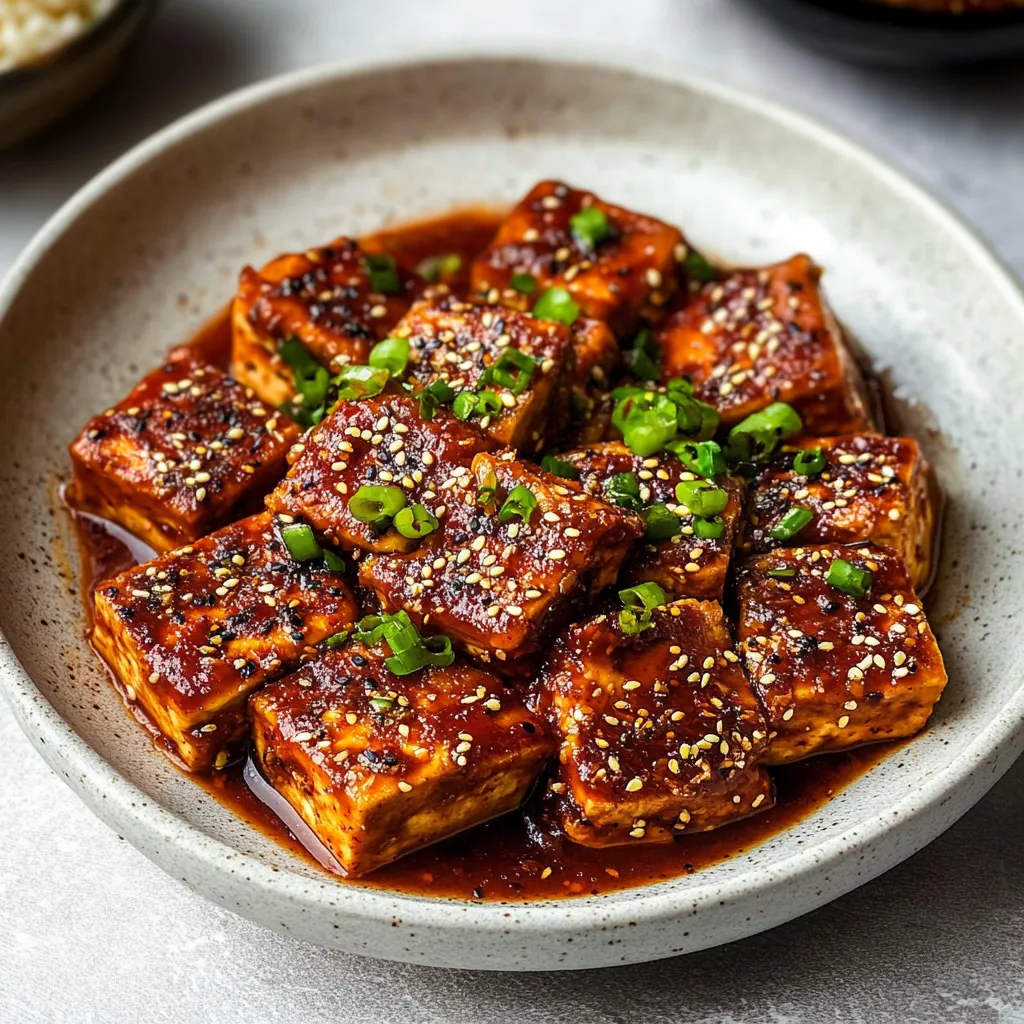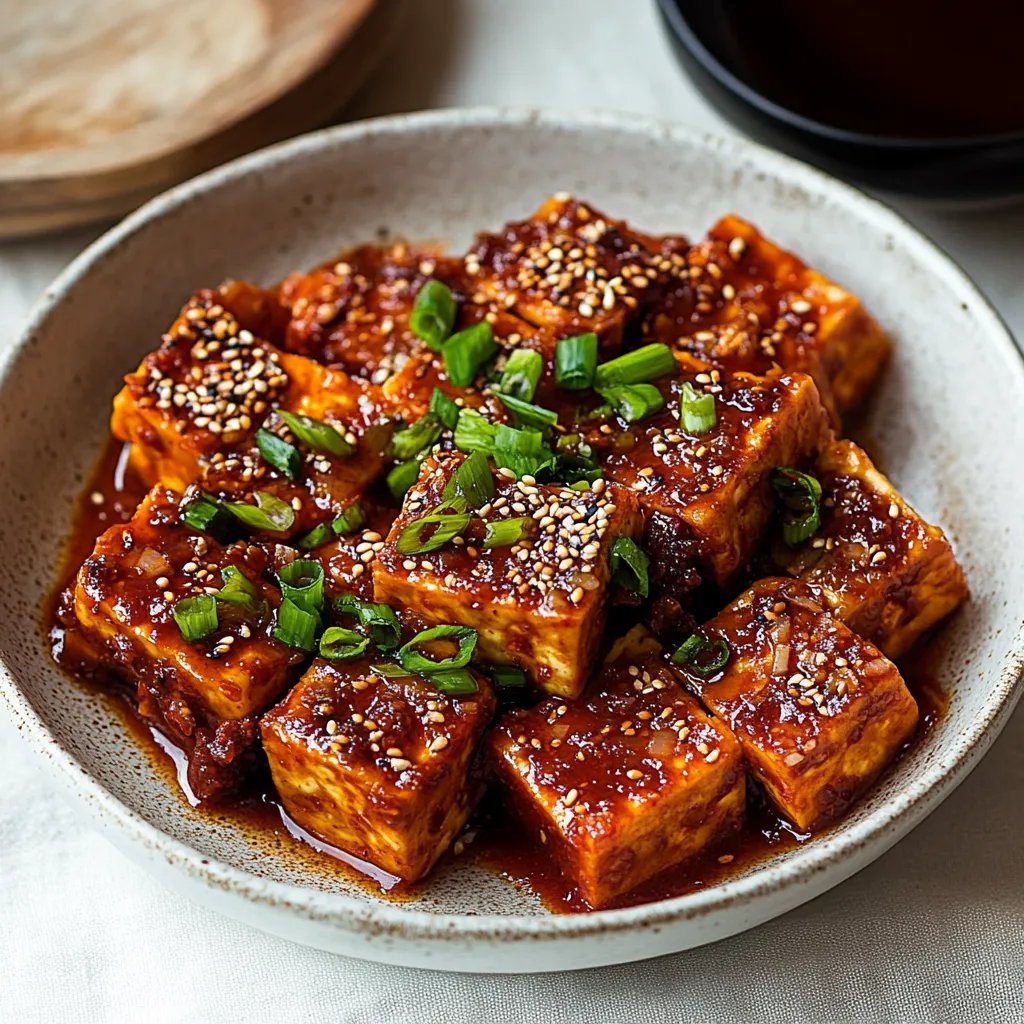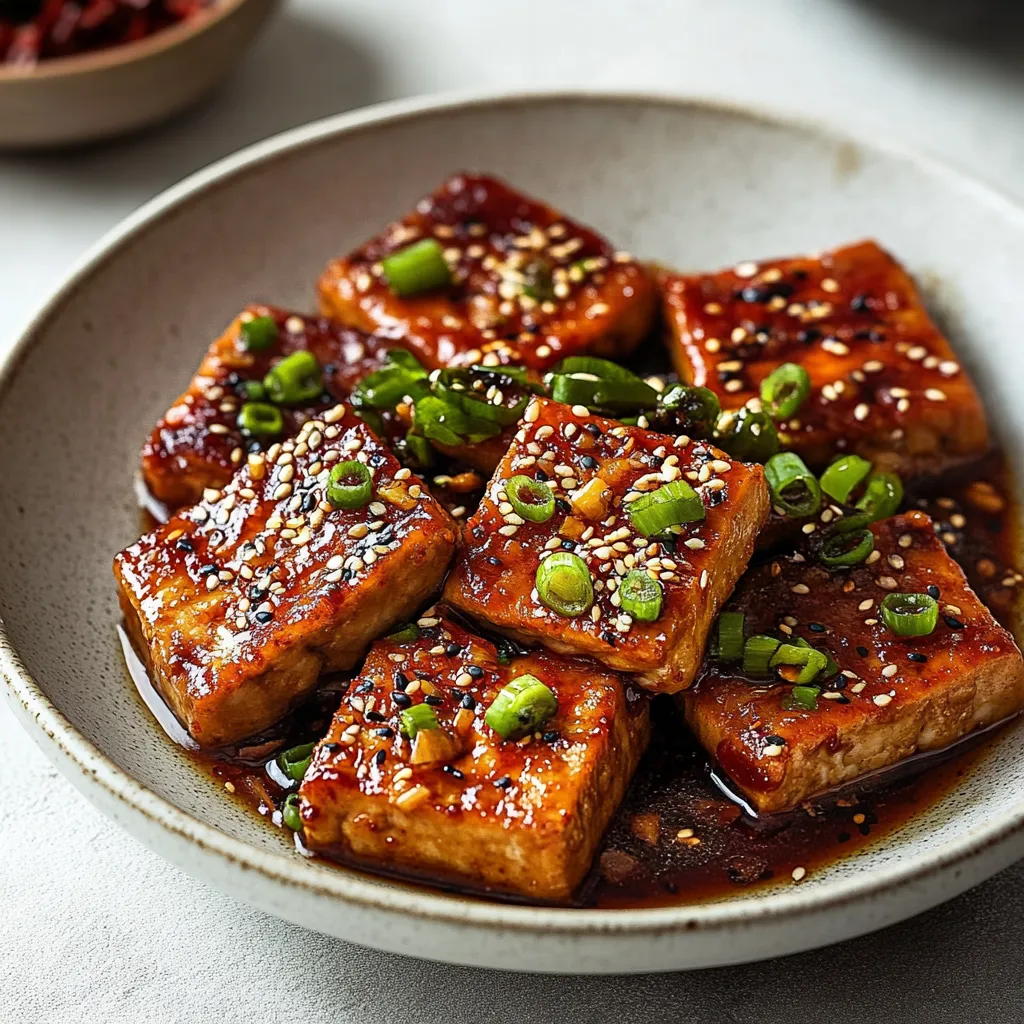 Pin it
Pin it
This dubu jorim recipe transforms simple tofu into a flavor-packed Korean delicacy that will impress even tofu skeptics. The perfect balance of savory, sweet, and spicy elements creates a dish that's both comforting and exciting. I discovered this recipe during my exploration of Korean home cooking and it's now my go-to weeknight protein option.
This dish reminds me of my first visit to a traditional Korean restaurant where I fell in love with the perfectly caramelized edges of braised tofu. After multiple attempts at home, I finally perfected this version that brings those same authentic flavors to my dinner table.
Ingredients
- Firm tofu: A protein-packed canvas that absorbs all the wonderful flavors while maintaining its satisfying texture
- Soy sauce: Provides the foundation of umami flavor (select low sodium if you prefer)
- Honey: Adds a gentle sweetness that balances the spice and soy sauce
- Gochugaru (Korean red pepper flakes): Brings that distinctive Korean heat (adjust to your preference)
- Garlic and green onions: Create an aromatic base that infuses the sauce
- Sesame oil: Adds a nutty finishing touch that elevates the entire dish
- Sesame seeds: Provide visual appeal and textural contrast
Step-by-Step Instructions
- Prepare the Sauce:
- Whisk together soy sauce, honey, gochugaru, water, minced garlic, and sliced green onions in a bowl. This simple mixture creates the foundation of flavors that will transform the tofu. Make sure the honey is fully dissolved for even sweetness throughout the dish.
- Pan Fry the Tofu:
- Heat vegetable oil in a nonstick pan over medium heat. Add the tofu slices and cook undisturbed for about 4 minutes until the bottom develops a golden crust. Flip carefully and cook the other side for another 4 minutes. The crisp exterior creates a wonderful textural contrast to the soft interior.
- Braise in Sauce:
- Pour the prepared sauce around the tofu slices in the pan. Let it bubble gently for about 5 minutes, spooning the sauce over the tofu repeatedly. This helps the tofu absorb the flavors while the sauce reduces and intensifies. The sauce should reduce by about half, becoming slightly syrupy.
- Finish with Sesame Oil:
- Drizzle sesame oil over the tofu and gently flip the pieces to distribute the oil evenly. The sesame oil adds a distinctive nutty aroma that is signature to Korean cuisine. Let it cook for another minute to allow the flavors to meld together.
- Garnish and Serve:
- Sprinkle sesame seeds over the tofu just before serving. The tofu can be served hot or at room temperature, making it perfect for meal prep. For an authentic Korean meal, serve alongside rice and a few vegetable side dishes.
 Pin it
Pin it
The gochugaru is truly the heart of this recipe. I always keep a container in my pantry specifically for Korean dishes. The first time I made this for my family who were skeptical about tofu, they couldn't believe how flavorful and satisfying it was. The way the spicy sweet sauce clings to the tofu creates the perfect bite every time.
Storage Tips
Properly stored dubu jorim will maintain its flavor and texture for up to 3 days in the refrigerator. I recommend using an airtight container to preserve freshness. The tofu actually tastes even better the next day as it continues to absorb the flavors of the sauce. To reheat, simply microwave for 30 seconds or gently warm in a pan with a splash of water to revive the sauce.
Ingredient Substitutions
If you cannot find gochugaru, you can substitute with a mixture of regular red pepper flakes and a pinch of paprika, though the flavor profile will be slightly different. For a vegan version, replace honey with brown sugar or maple syrup. Coconut aminos make an excellent gluten free alternative to soy sauce with a similar umami quality. If firm tofu isn't available, extra firm tofu works well too — just adjust the cooking time slightly as it contains less moisture.
Serving Suggestions
For an authentic Korean meal, serve dubu jorim with steamed rice and an assortment of banchan (small side dishes). Kimchi, cucumber salad, spinach namul, or seasoned bean sprouts make excellent accompaniments. For a quick lunch bowl, layer rice, dubu jorim, sliced avocado, and a sprinkle of furikake. This dish also pairs wonderfully with a cold Korean barley tea, especially during warmer months.
 Pin it
Pin it
This dish is simple yet incredible—it's bound to become a dinner favorite for anyone exploring Korean flavors!
Frequently Asked Questions
- → How spicy is Dubu Jorim typically?
Dubu Jorim can be adjusted to your preferred spice level. For a spicy version, use 1 tablespoon of gochugaru (Korean red pepper flakes). For moderate spice, use 1/2 tablespoon, and for a milder version, use just 1 teaspoon. The dish is customizable to suit different heat preferences.
- → Can I make Dubu Jorim vegan?
Yes, Dubu Jorim is easily made vegan by substituting the honey with sugar or another plant-based sweetener. All other ingredients in traditional Dubu Jorim are already plant-based.
- → What's the best type of tofu to use for Dubu Jorim?
Firm or extra-firm tofu works best for Dubu Jorim as it holds its shape during pan-frying and braising. Soft or silken tofu would fall apart during cooking. Be sure to pat the tofu dry before cooking to achieve a better golden crust.
- → What pan is best for cooking Dubu Jorim?
A non-stick pan is recommended for Dubu Jorim. Tofu tends to stick to cooking surfaces, which can cause the slices to break when flipping. While other pans can work, a non-stick surface makes the cooking process much easier and helps maintain the tofu's integrity.
- → Can I make Dubu Jorim gluten-free?
Yes, Dubu Jorim can be made gluten-free by using tamari or another gluten-free soy sauce alternative. Regular soy sauce typically contains wheat, but there are many brands that offer gluten-free versions.
- → What can I serve with Dubu Jorim?
Dubu Jorim pairs wonderfully with steamed rice and other Korean side dishes (banchan). Consider serving it with kimchi, seasoned spinach (sigeumchi namul), or Korean pickled vegetables. It also works well as part of a larger Korean meal or as a protein component in a rice bowl.
